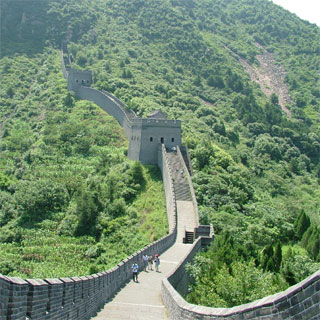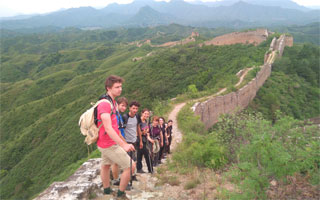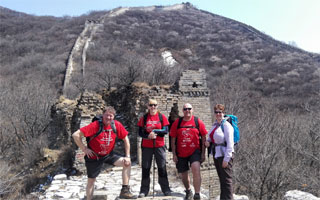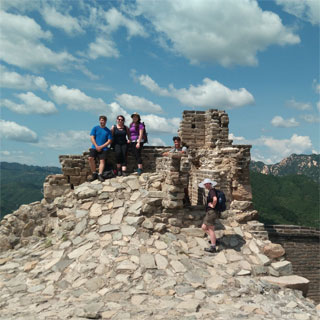
This tour starts with a visit to the East Qing Tombs, the burial site for most of China's last ruling dynasty. You'll then be taken to the Great Wall at Huangyaguan, which features classic brickwork, imposing watchtowers, and immense natural beauty. In fact, Huangyaguan is designed to be a miniature representation of the entire Great Wall, allowing you to get a keen insight on the structure in a much shorter time than it would take to walk the entire wall! After Huangyaguan we will embark for the classic Jinshanling hike, a restored piece of wall that will gradually deteriorate into its natural state as we cross west onto the Gubeikou section of Great Wall. Our next hike will be at Huanghuacheng, which features classically restored brickwork and some stunning scenery. About halfway through the hike we'll pass over into Xishuiyu, a little known section of Great Wall that is unrestored, meaning that the "wild wall" starts to take hold. The next day you'll be driven to the Jiankou Great Wall, which features dramatic peaks and ruins that are a photographer's dream. You'll soon hike over into Mutianyu, one of the most famous and popular sections of Great Wall, but one which has escaped the tackiness of other popular Great Wall spots.
Note: All the time and distance shown here are approximate and indicative only, if there is inconsistency, it will depend on the weather, local road condition and other actual situation.
This morning, we will drive about 3 hours to the spectacular East Qing tombs. The East Qing Tombs make up an imperial mausoleum complex from the last feudal empire in China, the Qing Dynasty (1644-1911). This sacred burial ground is located near Beijing in Zunhua, Hebei Province. The Eastern Qing Tombs are the final resting place of 5 emperors: Shunzhi, Kangxi, Qianlong, Xianfeng, and Tongzhi. In addition, there are also empresses, imperial concubines, princes, and princesses, all from the Qing Dynasty buried in the tombs. Their positioning within the tombs shows their relationships and the hierarchy of rulers and heirs, laid out in a branch-like system.
After lunch, we will make a one hour drive to Taipingzhai Village near Huangyaguan Great Wall. Huangyaguan is considered to be a miniature of the Great Wall of China. In this section, you can find the stone base built in the Northern Qi Dynasty (550 - 557) and the brick battlements laid in the Ming Dynasty (1368 - 1644). Watchtowers there are either solid or hollow, and have different shapes, including round ones and square ones. Outside, you may see independent outposts a few meters away from each other; inside, there are also ramparts to reinforce the defense system. Because the cliff rocks to the east of the pass are mostly yellow and they look gilded at the sunset, the pass got its name Huangya (Yellow Cliff) Pass.
There are two entrances to the scenic area: one is at Huangya Pass (main entrance) and the other is at Taiping Mountain Stronghold (east entrance). It is recommended to start from Taiping Mountain Stronghold and hike about 1.5-2 hours westwards to Huangya Pass. It is a relatively energy-saving route, because you will go downhill all the way to the pass. Besides, there are more farmhouses around the pass where you can have meals and rests. If you still feel very energetic after reaching the Huangya Pass, you can keep hiking westwards. With cracked stairs and collapsed towers along the way, an original section built in the Northern Qi Dynasty lies at the west end waiting for you to explore it.
Walking westward for 550 yards (503 meters) from the Huangya Pass, you will get to the steepest segment of this section, the Huangya Sky Ladder. Stairs there are not very smooth. Some of them even crack in the middle. Stretching to the top of the ridge, this long stairway seemingly leads to the sky. Climbing over the ladder(over 200 steps), you will reach the primitive Great Wall built in the Northern Qi Dynasty, marking the end of the Huangyaguan section.
Overnight in the courtyard hotel in Huangyaguan (two beds per room, with private washroom)

After breakfast, we will transfer directly by safe van to the Jinshanling section of the Great Wall. This is a 10 km hike from the renovated staircases of Jinshanling Great Wall westward to the authentic fortresses of the Gubeikou Great Wall. The scenery here is stunning and the photo opportunities endless. The Jinshanling to Gubeikou Great Wall hike is quit long but we can regain our strength during lunch at a local farmhouse about 30% into the hike. As there are no steep climbs a normal physical condition is enough to enjoy the trip. Note: Gubeikou to Jinshanling hike would be a little bit more difficult than the Jinshanling to Gubeikou hike, because the west terrain of Gubeikou is lower than the east part of Jinshanling, and travelers need to walk up from Gubeikou to Jinshanling. Both of this two trekking lines are stimulation and refreshing.
The hike starts with a climb of the infamous staircases of the JinshanLing Great Wall. The Jinshanling section has a total length of 10km with intact watchtowers almost every 100 meter. As we walk south, the Great Wall becomes less renovated, tourists become sparse and new views unfold. Just before we reach the restricted military zone we take a detour of the wall and up a hill top where you have a fantastic 360 degrees view of the Great Wall winding on the mountain ridges. We head down a small dirt trail that leads to a local farmer who will serve us an excellent lunch.
With renewed strength we follow a 5 km trail that curls alongside the wall, over the hills, trough a small forest and pops out of the bush at the General tower of the Gubeikou Great Wall. Here we have reached the highest point of the day and another magic place for pictures, 24 Eyes Tower. It's named as such because it was built with six windows on each sides. The winding dragon section and Crouching Tiger section of Gubeikou Great Wall are stretched out in front of you. We hike the Gubeikou Great Wall till the 3rd watchtower and take a small dirt trail down ridge, trough the bush till we reach a small lake where our driver waits for us. By 7pm we will go back to the hotel in Jinshanling.
Overnight in the hostel at the bottom of Jinshanling Great Wall (two persons per room, with private washroom)

In the morning, take a 2-hour drive to Xizhazi village located at Huairou. We will spend the third day on the Jiankou section of the Wall, recognized as one of most beautiful parts of the "Wild Wall" near Beijing, and much-loved by photographers. Not visited often by "typical" tourists, this section is really rough and broken. Although we will have to be careful walking on it, the opportunity for pictures in this section is unequalled! With memories (and memory cards) full of pictures, we will then have a late lunch at a restaurant near Mutianyu, after enjoying a leisurely lunch, we will start our drive to Huanhuacheng, check in a local guesthouse and have a rest.

After breakfast, take a short drive to the startpoint of the last day's hike, upon arrival, hike westward to Xishuiyu. Huanghuacheng Great Wall is the only one section in Beijing that was built through a lake. The whole section is defined in three segments by water. When summer arrives in full bloom, the entire village below is awashed in a sea of yellow wild flowers ('yellow flower' is 'huanghua' in Chinese). Hence the village name Huanghuacheng (Huanghua City in English), and by turn the Great Wall section acquires its name. This section of the wall is completely unrestored and still remains its plain character since its construction commenced in 1404, two years before the Ming Dynasty moved its capital to Beijing, and continued for 188 years.
The hike today is not too long, but it is very special – part of the Wall is underwater! When the water level rose, some low-lying sections of the Wall were submerged. Seen from the reservoir dam of Huanghuacheng, built on the former site of Xishuiyuguan Pass in 1974, the stately sunken wall is still visible under the water's smooth surface. We will not go swimming but will start our hike westward to Xishuiyu, following some of the Wall that meanders for 14km over gently-undulating hills, with occasional steep parts. We will examine some of the ancient structures (e.g. towers, gates) as we hike along.
There are several up-and-down parts, however fortunately the mountains here are not that high or steep. First, there is a good trail alongside the Wall, after about half an hour we will get to a watchtower on the cliff. Here is a great place to take photos, one of which must be of the moon-shaped reservoir at the bottom of the mountain. Then, after another half-an-hour hiking, we will reach the highest point in this area, on the pinnacle of which there is another broken watchtower. From this vantage point you will have a nice sunny panoramic view of the whole wide valley, stretching even further toward the west. From the top point, the wall dives steeply downwards into the valley. After walking down by the steps, we will reach a platform. Under the platform at the bottom, there is a Gate, a opening in the wall leading to the Zhuangdaokou village down to the south, and Yaoziyu Fort uphill to the north. Then, continue with hiking westward, climbing upwards along the broken Wild Wall covered by trees to our lunch spot, a tall cliff overlooking Xishuiyu Lake. From here, the view is amazing! You can see the broken Wall running directly into the lake, and beyond it, the endless mountain range.
Unfortunately, from here on, the Wall is really too broken to traverse safely, so we will instead follow a pleasant mountain trail downwards into Xishuiyu Village, where we will enjoy today's lunch. After lunch, drive back to Beijing.
-End of Tour-

| Cancellation in advance | Cancellation penalty |
|---|---|
| More than 30 days | No Cancellation Fee |
| 30-10 days | 50% of the full payment |
| 9-0 days or no show | 100% of the full payment |
Enough films and batteries, Sun-cream with the protection index of 40-60, sunglasses with a sun protection factor of 15, the lip creams and balms with SPF rating, towel, toothpaste, electric torch, Snack foods.
Cloth that you bring must be warm enough and can be removed easy enough according to the weather, including Jacket, hat, Cotton underwear, Socks, Long-sleeve Shirts, T-shirts and Pants (Shorts are not appropriate at any time while hiking), comfortable shoes, rain gear (long rain coat is better)
Medicine: In addition to the normal medications for traveling, just like the Aspirin and medicine for diarrhea, siriasis,sunstroke and carsickness.
US$ is acceptable only in a very limited range, e.g. tips. However, for convenience, Chinese currency is the best choice. If you want to change US$ to Chinese currency in the tour, you can change it in the Hotel you stay or in the Bank of China. You could draw cash only from Bank of China in the big city, the ATM there doesn't always work properly and the bank is not easy to find. Please bring some cash at hand to use.
a) Eating is an important part of your China experience. Generally breakfasts are included in the itinerary and offered by hotels. CAT recommends local Chinese restaurants that are popular with local people for lunch. You can order dishes with the help of your guide. We usually leave dinner for your own choice — Western food can be found in most large cities.
b) We have tried to arrange various food in different cities. But you may still think the food is simple and not as delicious as in the big cities especially while trekking in the mountains and villages. If you have any priority of the food (eg. If you are vegetarian or you are allergic to MSG, peanut oil, fish and peanut, etc) please inform us early, we will try to alternate the food accordingly. At the same time please prepare some of your favorite snacks and substitution food in case of need.
c) Meals in the home stays will be different from the cities but clean, which leave you a good chance to experience the ethnic minority culture. We will pack a breakfast for you of cold cereal, milk, toast, fruit, and jam for the home stay.
d) It is very important to drink a lot of water and eat enough fruit in your tour especially while trekking in the mountains and villages. You are advised not to drink tap water.
Hotels in China are bound by Government laws which mean that air conditioning is switched on nationally in May and the central heating in November (this may vary slightly depending on the region).
In some remote areas, sometimes shower maybe not available in the home stay. A married couple is not allowed to share a room in the Miao's home-stay due to the local customs.
It is customary to tip service providers in the travel industry in Asia, depending on the service. Tipping is expected — though not compulsory — and shows an expression of satisfaction with the people who have assisted you on your tour. Recommendations for tipping drivers (5-8 USD per person per day as a guideline) and local guides (8-15 USD per person per day as a guideline) would depend on the quality and length of the service.
We use comfortable sedans or vans with air-conditioning. The comfort and safety of our customers is of utmost importance, so we ensure that all of the vehicles we use are well maintained and always very clean. Our drivers take pride in their vehicles.
In some provinces with many minorities (like Guizhou, Guangxi, Tibet, Xinjiang and etc.), the customs and habits of local people are different from place to place. The local guide will inform you what should care. Respect the local customs and religions. The people are very kind and hospitable. You can feel free to talk with them. But there are some rulers you should go by!
a. Do not photo them without getting the permit, please show the respect to them!
b. Don't talk the sensitive topics like the political and the religion matters!
When you sign up for the trekking tour, you acknowledge that there are risks involved in trekking in high altitude and confirm that you are fully aware of and accept these risks. It is customer's responsibility to determine whether the tour he/she choose is suited to his/her physical condition. Customers are responsible for the cost of any medicines or medical care they may require during the trip for any reason. Please make sure you have adequate personal medical insurance to meet any medical emergency which might arise. In some cases, if you need medical care during the tour, you may be required to pay for it at the time it is rendered and seek reimbursement from your insurer after you return home. Please check with your medical insurer for details. In the event of a medical emergency, we will make every effort to assist you in obtaining necessary care. Also, please tell us in writing if you suffer from any allergies or other physical conditions which might affect you during the tour (if you hasn't tell us in writing before going, you are supposed to be healthy enough to take the tour). Finally, please check with your doctor to find out what inoculation may be recommended for the areas you will be visiting. It is your responsibility to obtain all necessary inoculations. We reserve the right to decline to accept any person as a member of the tour, or to decline to retain any person, if such person's physical condition, mental well-being or behavior interferes with the operation of the tour. There will be no refund in such cases.